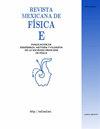石墨烯色散能量模拟中的误解
Q4 Social Sciences
引用次数: 0
摘要
这项研究旨在找到满足石墨烯能量色散特性的方程和模拟,并确定可能发生的误解。在这里,我们给学生们九篇关于石墨烯分散能的文章。他们被要求确定每一篇文章中使用的方程、参数和软件。然后,任务是在电子表格中对数据进行分配。使用的参数是2.46Å的晶格常数,x和y轴的k波函数范围为-2πa到2πa,每个范围的间隔为0.1。每个方程分为两部分,E(+)和E(-)。通过在x轴和y轴以及主对角线和离对角线的中间制作切片来进行分析。石墨烯具有带隙为零的狄拉克点。这意味着价带和导带之间没有距离或距离很小。从这一活动中可以得出结论,Rozhkov(2016)拥有最能满足石墨烯分散能的方程和模拟。在几乎所有现有的方程和模拟中都会出现误解。本文章由计算机程序翻译,如有差异,请以英文原文为准。
The misconception in graphene’s dispersion energy simulations
This study aims to find equations and simulations that satisfy the characteristics of graphene’s energy dispersion and identify misconceptions that may occur. Here we give students nine articles about graphene’s dispersion energy. They were asked to identify the equations, parameters, and software used in each of the articles. The assignment was then to make the distribution of the data in a spreadsheet. The parameters used were the lattice constant of 2.46 Å, the range of the k wave function for the x and y axes of -2πa to 2πa, and the interval for each range of 0.1. Each equation is divided into two parts, E(+) and E(-). The analysis was carried out by making a slice in the middle of the x and y axes, as well as the main and off-diagonals. Graphene has Dirac points where the band gap is zero. This means that there is no distance or very small distance between the valence and conduction bands. From this activity, it can be concluded that Rozhkov (2016) has the equations and simulations that best satisfy graphene’s dispersion energy. Misconceptions occur in almost all existing equations and simulations.
求助全文
通过发布文献求助,成功后即可免费获取论文全文。
去求助
来源期刊

Revista Mexicana De Fisica E
社会科学-科学史与科学哲学
CiteScore
0.80
自引率
0.00%
发文量
14
审稿时长
>12 weeks
期刊介绍:
The Revista Mexicana de Física (Rev. Mex. Fis.) publishes original papers of interest to our readers from the physical science com unity. Language may be English or Spanish, however, given the nature of our readers, English is recommended. Articles are classified as follows:
Research. Articles reporting original results in physical science.
Instrumentation. Articles reporting original contributions on design and construction of scientific instruments. They should present new instruments and techniques oriented to physical science problems solutions. They must also report measurements performed with the described instrument.
Reviews. Critical surveys of specific physical science topics in which recent published information is analyzed and discussed. They should be accessible to physics graduate students and non specialists, and provide valuable bibliography to the specialist.
Comments. Short papers (four pages maximum) that assess critically papers by others authors previously published in the Revista Mexicana de Física. A comment should state clearly to which paper it refers.
 求助内容:
求助内容: 应助结果提醒方式:
应助结果提醒方式:


